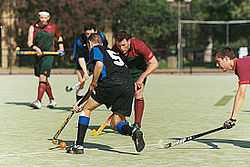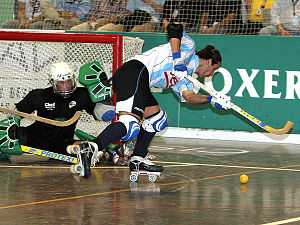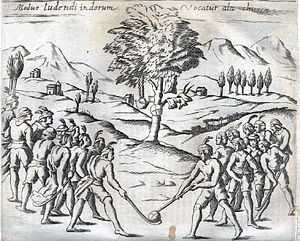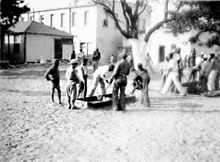Hockey
Hockey is a family of sports in which two teams play against each other by trying to maneuver a ball or a puck into the opponent's goal using a hockey stick. In many areas, one sport (typically field hockey or ice hockey[1]) is generally referred to simply as hockey.
Etymology
The first recorded use of the word "hockey" is from the 1773 book Juvenile Sports and Pastimes, to Which Are Prefixed, Memoirs of the Author: Including a New Mode of Infant Education, by Richard Johnson (Pseud. Master Michel Angelo), whose chapter XI was titled "New Improvements on the Game of Hockey".[2] The belief that hockey was mentioned in a 1363 proclamation by King Edward III of England is based on modern translations of the proclamation, which was originally in Latin and explicitly forbade the games "Pilam Manualem, Pedivam, & Bacularem: & ad Canibucam & Gallorum Pugnam". The English historian and biographer John Strype did not use the word "hockey" when he translated the proclamation in 1720.
The word hockey itself is of unknown origin. One explanation is that it is a derivative of hoquet, a Middle French word for a shepherd's stave.[3] The curved, or "hooked" ends of the sticks used for hockey would indeed have resembled these staves. Another explanation is that the cork bungs that replaced wooden balls in the 18th century came from barrels containing "Hock" ale, also called "Hocky".[4]
History
Games played with curved sticks and a ball can be found in the histories of many cultures. In Egypt, 4000-year-old carvings feature teams with sticks and a projectile, hurling dates to before 1272 BC in Ireland, and there is a depiction from approximately 600 BC in Ancient Greece where the game may have been called kerētízein or kerhtízein (κερητίζειν) because it was played with a horn or horn-like stick(kéras, κέρας)[5] In Inner Mongolia, the Daur people have been playing beikou, a game similar to modern field hockey, for about 1,000 years.[6]
Most evidence of hockey-like games during the Middle Ages is found in legislation concerning sports and games. The Galway Statute enacted in Ireland in 1527 banned certain types of ball games, including games using "hooked" (written "hockie", similar to "hooky") sticks.[7]
...at no tyme to use ne occupye the horlinge of the litill balle with hockie stickes or staves, nor use no hande ball to play withoute walles, but only greate foote balle[8]
By the 19th century, the various forms and divisions of historic games began to differentiate and coalesce into the individual sports defined today. Organizations dedicated to the codification of rules and regulations began to form, and national and international bodies sprung up to manage domestic and international competition. Ice hockey also evolved during this period as a derivative of field hockey adapted to the icy conditions of Canada and the northern United States.
Subtypes

Field hockey
Field hockey is played on gravel, natural grass, sand-based or water-based artificial turf, with a small, hard ball approximately 73 mm (2.9 in) in diameter. The game is popular among both males and females in many parts of the world, particularly in Europe, Asia, Australia, New Zealand, South Africa, and Argentina. In most countries, the game is played between single-sex sides, although they can be mixed-sex.
The governing body is the 126-member International Hockey Federation (FIH). Men's field hockey has been played at each summer Olympic Games since 1908 (except 1912 and 1924), while women's field hockey has been played at the Summer Olympic Games since 1980.
Modern field hockey sticks are J-shaped and constructed of a composite of wood, glass fibre or carbon fibre (sometimes both) and have a curved hook at the playing end, a flat surface on the playing side and curved surface on the rear side. All sticks are right-handed – left-handed sticks are not permitted. While current field hockey appeared in mid-18th century England, primarily in schools, it was not until the first half of the 19th century that it became firmly established. The first club was created in 1849 at Blackheath in south-east London. Field hockey is the national sport of Pakistan.[9] It was the national sport of India until the Ministry of Youth Affairs and Sports declared that India has no national sport in August 2012.[10]
Ice hockey
Ice hockey is played on a large flat area of ice, using a three-inch-diameter (76.2 mm) vulcanized rubber disc called a puck. This puck is often frozen before high-level games to decrease the amount of bouncing and friction on the ice. The game is contested between two teams of skaters. The game is played all over North America, Europe and in many other countries around the world to varying extent. It is the most popular sport in Canada, Finland, Latvia, the Czech Republic, and Slovakia.
The governing body of international play is the 72-member International Ice Hockey Federation (IIHF). Men's ice hockey has been played at the Winter Olympics since 1924, and was in the 1920 Summer Olympics. Women's ice hockey was added to the Winter Olympics in 1998. North America's National Hockey League (NHL) is the strongest professional ice hockey league, drawing top ice hockey players from around the globe. The NHL rules are slightly different from those used in Olympic ice hockey over many categories.
Ice hockey sticks are long L-shaped sticks made of wood, graphite, or composites with a blade at the bottom that can lie flat on the playing surface when the stick is held upright and can curve either way, legally, as to help a left- or right-handed player gain an advantage.
Various stick and ball games similar to field hockey, bandy and other games where two teams push a ball or object back and forth with sticks were played on ice under the name "hockey" in England throughout the 19th century, and even earlier under various other names.[11] In Canada, there are 24 reports[12] of hockey-like games in the 19th century before 1875 (five of them using the name "hockey"). The first organized indoor game of ice hockey was played in Montreal, Canada on March 3, 1875 and featured several McGill University students. The contemporary sport developed in Canada from these and other influences. International ice hockey rules were adopted from Canadian rules in the early 1900s.[13]
Ice hockey is the national sport of Latvia[14] and the national winter sport of Canada.[15]
Ice hockey is played at a number of levels, by all ages.
Roller hockey (quad)
Roller hockey, also known as quad hockey, international-style ball hockey, and Hoquei em Patins is an overarching name for a roller sport that has existed since long before inline skates were invented. This sport is played in over sixty countries and has a worldwide following. Roller hockey was a demonstration sport at the 1992 Barcelona Summer Olympics.
Roller hockey (inline)

Inline hockey is a variation of roller hockey very similar to ice hockey, from which it is derived. Inline hockey is played by two teams, consisting of four skaters and one goalie, on a dry rink divided into two halves by a center line, with one net at each end of the rink. The game is played in three 15-minute periods with a variation of the ice hockey off-side rule. Icings are also called, but are usually referred to as illegal clearing. For rink dimensions and an overview of the rules of the game, see IIHF Inline Rules (official rules). Some leagues and competitions do not follow the IIHF regulations, in particular USA Inline and Canada Inline.
Sledge hockey
Sledge hockey is a form of ice hockey designed for players with physical disabilities affecting their lower bodies. Players sit on double-bladed sledges and use two sticks; each stick has a blade at one end and small picks at the other. Players use the sticks to pass, stickhandle and shoot the puck, and to propel their sledges. The rules are very similar to IIHF ice hockey rules.[16]
Canada is a recognized international leader in the development of the sport, and of equipment for players. Much of the equipment for the sport was first developed in Canada, such as sledge hockey sticks laminated with fiberglass, as well as aluminum shafts with hand carved insert blades and special aluminum sledges with regulation skate blades.
Based on ice sledge hockey, inline sledge hockey is played to the same rules as inline puck hockey (essentially ice hockey played off ice using inline skates) and has been made possible by the design and manufacture of inline sledges by RGK, Europe’s premier sports wheelchair maker.
There is no classification point system dictating who can play inline sledge hockey, unlike the situation with other team sports such as wheelchair basketball and wheelchair rugby. Inline sledge hockey is being developed to allow everyone, regardless of whether they have a disability or not, to complete up to world championship level based solely on talent and ability. This makes inline sledge hockey truly inclusive.
The first game of inline sledge hockey was played at Bisley, England, on the 19th of December 2009 between the Hull Stingrays and the Grimsby Redwings. Matt Lloyd is credited with inventing inline sledge hockey, and Great Britain is seen as the international leader in the game's development.
Street hockey
Also known as road hockey, this is a dry-land variant of ice and roller hockey played on a hard surface (usually asphalt). Most of the time, a ball is used instead of a puck, and generally no protective equipment is worn. Street hockey is played year round.
Other forms of hockey

Other games derived from hockey or its predecessors include the following:

- Air hockey is played indoors with a puck on an air-cushion table.
- Beach hockey, a variation of street hockey, is a common sight on Southern California beaches.
- Ball hockey is played in a gym using sticks and a ball, often a tennis ball with the felt removed.
- Bandy is played with a ball on a football field-sized ice arena, typically outdoors, and with many rules similar to association football. It is played professionally in Russia and Sweden and is considered a national sport in Russia. The sport is recognised by the IOC and is administrated internationally by the Federation of International Bandy.
- Box hockey is a school yard game played by two people. The object of the game is to move a hockey puck from the center of the box out through a hole placed at the end of the box (known as the goal). Each player kneels and faces one another on either side of the box, and each attempts to move the puck to the hole on their left.
- Broomball is played on an ice hockey rink, but with a ball instead of a puck and a "broom" (actually a stick with a small plastic implement on the end) in place of the ice hockey stick. Instead of using skates, special shoes are used that have very soft rubbery soles to maximize grip while running around.
- Deck hockey is traditionally played by the Royal Navy on the ships' decks, using short wooden 'L' shaped sticks.
- Floor hockey is a form of hockey played on foot, on a flat, smooth floor surface. It is usually played inside in gymnasiums or similar.
- Floorball is a form of hockey played in a gymnasium or in a sports hall. A whiffle ball is used instead of a plastic ball, and the sticks are made from composite materials. The sticks are only one meter long.
- Foot hockey or sock hockey is played using a bald tennis ball or rolled up pair of socks and using only the feet. It is popular at elementary schools in the winter.
- Gym hockey is a form of ice hockey played in a gymnasium. It uses sticks with foam ends and a foam ball or a plastic puck.
- Hurling and Camogie are Irish games bearing some resemblance to – and notable differences from – hockey.
- Indoor field hockey is an indoor variation of field hockey.
- Mini hockey In the United States is a form of hockey (also known as "mini-sticks") which is played in basements of houses. Players get down on their knees, using a miniature plastic stick, usually about 15 inches (38 cm) long to maneuver a small ball or a soft, fabric covered mini puck into a miniature goals. In England 'mini hockey' refers to a seven-a-side version of field hockey, played on an area equivalent to half a normal pitch for younger players
- Nok Hockey is a table-top version of hockey played with no defense and a small block in front of the goal.
- Power hockey is a form of hockey for persons requiring the use of an electric (power) wheelchair in daily life. PowerHockey is a competitive sports opportunity for the physically disabled.
- Ringette is an ice hockey variant that was designed for female players; it uses a straight stick and a rubber ring in place of a puck. Note: Ringette distances itself from hockey as it has its own set of rules and is closely related to a mix of lacrosse and basketball.
- Rink bandy is played like bandy but on an ice hockey rink and with fewer players on each team.
- Rinkball is a Scandinavian team sport, played in an ice hockey rink with a ball.
- Rossall hockey is a variation played at Rossall School on the sea shore in the winter months. Its rules are a mix of field hockey, rugby and the Eton wall game.
- Shinny is an informal version of ice hockey.
- Shinty is a Scottish game now played primarily in the Highlands
- Skater hockey is a variant of inline hockey, played with a ball.
- Spongee is a cross between ice hockey and broomball and is most popular in Manitoba, Canada. A stick and puck are used as in hockey (the puck is a softer version called a "sponge puck"), and the same soft-soled shoes used in broomball are worn. The rules are basically the same as ice hockey, but one variation has an extra player on the ice called a "rover".
- Table hockey is played indoors with a table-top game.
- Underwater hockey is played on the bottom of a swimming pool.
- Unicycle hockey is played on a hard surface using unicycles as the method of player movement. There is generally no dedicated goalkeeper.
References
- Gidén, Carl; Houda, Patrick; Martel, Jean-Patrice (2014). On the Origin of Hockey. Createspace. ISBN 9780993799808.
- Podnieks, Andrew; Szemberg, Szymon (2007). World of hockey : celebrating a century of the IIHF. Fenn Publishing. ISBN 9781551683072.
- ↑ Liebeck, Elaine; Pollard, Helen, eds. (1994). The Oxford Paperback Dictionary (4th ed.). Oxford, England: Oxford University Press. ISBN 0-19-280012-4.
- ↑ Gidén, Houda & Martel 2014, p. 50.
- ↑ "Hockey". Online Etymology Dictionary. Retrieved 2011-06-18.
- ↑ Gidén, Houda & Martel 2014, p. 235.
- ↑ Oikonomos, G. (1920). Κερητίζοντες 6. Archaiologikon Deltion. pp. 56–59. Retrieved 2011-06-18.
- ↑ McGrath, Charles (August 22, 2008). "A Chinese Hinterland, Fertile with Field Hockey". The New York Times. Retrieved 2008-08-23.
- ↑ Birley, Derek (1993). Sport and the Making of Britain. Manchester University Press. p. 309. Retrieved 2014-06-22.
- ↑ "History of Field hockey". Retrieved 2011-06-18.
- ↑ "Hockey in Pakistan". Retrieved 2011-06-18.
- ↑ "Hockey is not our national game: Ministry". The Times Of India. Retrieved 2013-05-03.
- ↑ Gidén, Houda & Martel 2014.
- ↑ Gidén, Houda & Martel 2014, pp. 24,25,248.
- ↑ Podnieks & Szemberg 2007, p. 198.
- ↑ (Latvian) "Nacionālie sporta veidi...". Retrieved 15 November 2009.
- ↑ National Sports Act of Canada (1994)
- ↑ International Paralympic Committee. "Ice Sledge Hockey — Rulebook" (PDF). Retrieved October 11, 2006.
External links
| ||||||||||||||||||||||||||||||||||||||||||||||||||||||||||||||